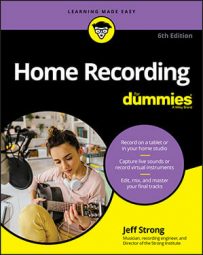 © PrinceOfLove / Shutterstock.com
© PrinceOfLove / Shutterstock.comWords to know as a music producer
When you produce your own music at home, you need to know the language of the music-recording industry. This glossary lets you in on the secret (or not-so-secret) language of the record producer. Read and be enlightened (or not)!
Air: Refers to frequencies above 12 kHz. A quality that allows the song to breathe a little. A feeling of spaciousness. Similar to shimmer.
Angular: This means nothing. If people use this term, ask them to explain themselves. They’ve just gone over the deep end.
Body: The frequency range of an instrument where it produces its richest tone, often around 800 Hz to 1 kHz.
Boomy: Too much low-frequency energy. To get rid of boominess, cut frequencies below 120 Hz.
Boxy: Too much 400-Hz to 600-Hz energy.
Bright: Lots of high end, usually referring to frequencies above 8 kHz.
Brown: A term for the sound that Eddie Van Halen used to get from his guitar amp. Brown usually refers to a low midrange quality (200 to 400 Hz) — not to be confused with muddy, however.
Cold: Lacking warmth. Often used as a derogatory term to describe digital recordings. It could also mean too much high end in a recording. In this case, reduce frequencies above 10 kHz slightly.
Crisp: See bright.
Dark: Lacking high-frequency brightness. Could also be dull.
Depth: Full-bodied sound. Often the result of enhancing frequencies just above and below the main body of the instrument.
Dry: An instrument without effects applied to it.
Dull: See dark.
Edgy: An extreme of punchy, bordering on uncomfortable, depending on the music.
Grainy: Poor digital resolution.
Harsh: Another derogatory term for digital recordings. This could also refer to frequencies in the 5-kHz to 8-kHz range that are too pronounced. Reduce harsh frequencies to suit your taste.
Muddy: Lack of definition in a sound, often as a result of too much low-mid (400- to 800-Hz) energy.
Nasally: Too much midrange energy, around 1 to 2 kHz in some instruments.
Orange: Get this guy out of your studio; he’s just making stuff up!
Plosives: The result of saying or singing p or other stop consonant sounds(t, g, k, d, b).
Presence: A nice balance between an instrument’s attack and its main tone. Usually attained by adding 2- to 5-kHz frequencies.
Punchy: A nice attack and sense of presence. A punchy sound can come from your performance, your instrument, or the effective use of compression (or all three). To create punch with a compressor, set the threshold to compress just a couple of decibels (dB), set the attack long enough so that the initial transient passes through uncompressed, and set the release so that it doesn’t remain longer than the instrument and so that it isn’t short enough to pump the compressor.
Round: Sometimes refers to sounds that have a pronounced midrange quality. When a sound is round, bass and treble are slightly reduced.
Shimmer: Frequencies above 12 kHz. Similar to air.
Sibilance: Pronounced s sounds.
Smooth: The opposite of punchy. Smooth sounds are those that have an even level to them. The body of the sound is not overshadowed by the initial attack.
Sweet: Good or great, depending on how enthusiastically you use the word.
Warm: Lacking harshness or coldness. This is a catchall term used to describe anything from analog equipment to a pleasing quality that can’t be put into words. Use this term around nonrecording people whenever you want to sound like you know what you’re talking about. When someone else uses this term repeatedly, take his or her recording advice with a grain of salt (a large one).
Wet: An instrument with effects applied to it.
Setting effects parameters in your home recording studio
Every effect (signal processor) that you use in your home-recording studio has certain settings, called parameters, which you can adjust to tailor the sound to your liking. The compressor and reverb are the two most common effects (signal processors).
Choosing reverb parameters
Reverb is a natural part of every sound and represents the way a room sounds as a sound bounces around it.
-
Room size/type: Whether you use a reverb patch within your DAW (Digital Audio Workstation) or a separate outboard reverb unit, you can choose the type of reverb that you want to use. You have the option of a room, hall, or plate (a type of reverb that uses a metal plate to create the sound). As well, you can choose the size of the room in either meters or feet.
-
Decay: The decay is the length of time that the reverb lasts. Larger or more reflective rooms produce a longer decay.
-
Predelay: The predelay is the amount of time from the sound’s beginning to the start of the reverb (described in milliseconds). Predelay helps to define the initial sound signal by separating it from the reverb. This parameter is essential in making your reverb sound natural.
-
Density: The density parameter controls the level of the early reflections (the first few milliseconds of the reverb sound). This parameter enables you to simulate different sizes of rooms because, in a larger room, the main section of a reverb takes longer to reach you.
-
Diffusion: Diffusion affects the density of the reflections in the main section of the reverb sound. A higher diffusion setting results in a thicker sound.
Controlling compressor settings
The compressor is used to compress the dynamic range of your signal and is used in all the stages of recording: tracking, mixing, and mastering.
-
Threshold: The threshold setting dictates the level where the compressor starts to act on the signal. This is listed in dB (decibels).
-
Ratio: The ratio is the amount that the compressor affects the signal. For example, a ratio of 2:1 means that if a signal goes 1dB over the threshold setting, its output from the compressor is only 1/2dB louder.
-
Attack: The attack knob controls how soon the compressor kicks in. The attack is defined in milliseconds (ms), and the lower the number, the faster the attack.
-
Release: The release parameter controls how long the compressor continues affecting the signal after it has started. Like the attack, the release is defined in milliseconds.
-
Gain: You use the gain knob to adjust the level of the signal going out of the compressor. This is listed in decibels. Because adding compression generally reduces the overall level of the sound, you use this control to raise the level back to where it was going in.

